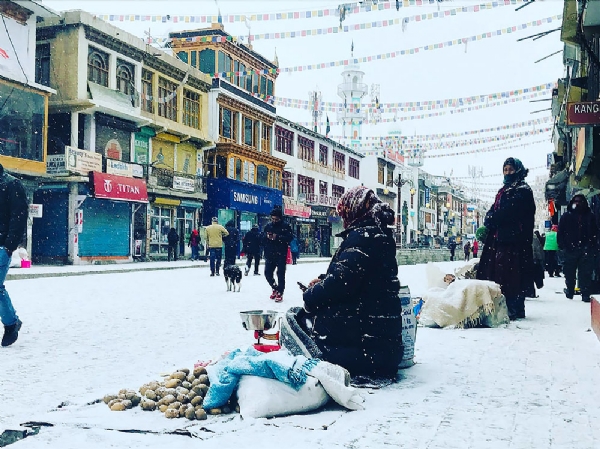Exploring Winters in Bharat: Surviving the Himalayan Chill with Ladakh's Ancient Winter Practices
As Ladakh embraces the winter months with a resilience that echoes through generations, these traditional practices serve as a testament to the community"s profound connection with nature.
Total Views |
As winter blankets the high-altitude landscapes of Ladakh , the residents of this remote Himalayan region have perfected time-tested traditions to not just endure but thrive in the cold. In Ladakh, where temperatures often plummet well below freezing, the locals have developed an intricate set of practices that go beyond modern heating systems. These traditional methods not only keep the body warm but also reflect the deep connection between the people of Ladakh and their environment.

1. Kangri – The Portable Heater:
At the heart of Ladakh's winter survival kit is the Kangri, a traditional portable heater. Crafted from willow twigs and covered with clay, the Kangri holds burning coals within its earthen walls. This ingenious device, tucked under layers of clothing, radiates warmth and has been a constant companion for Ladakhis for generations. The Kangri is not just a source of physical warmth; it symbolizes a cultural warmth that binds communities together during the harsh winter months.
2. Pashmina Shawls – Nature's Insulation:
Pashmina, the renowned fine wool from Ladakh's Changthangi goats, is not just a fashion statement but a vital winter accessory. Pashmina shawls are luxuriously soft and provide exceptional insulation against the biting cold. Worn elegantly by Ladakhi women and men alike, these shawls are not merely a style choice but a practical necessity, reflecting the seamless integration of tradition and functionality in Ladakh's lifestyle.
3. Thukpa and Butter Tea – Warming from Within:
Ladakhi cuisine plays a crucial role in combating the winter chill. Thukpa, a hearty noodle soup with vegetables or meat, is a staple that warms both the body and soul. Laden with spices and piping hot, Thukpa is a go-to dish during the bone-chilling Ladakhi winters. Similarly, the famous Butter Tea, or 'gur gur chai,' provides a caloric boost and helps combat the cold. Rich in energy, the combination of these culinary delights is a testament to Ladakh's culinary wisdom.
4. Stok Kangri Blankets – Heritage Weaves:
Stok Kangri blankets, woven with intricate patterns and vibrant colors, are a hallmark of Ladakhi craftsmanship. Beyond their aesthetic appeal, these blankets offer insulation against the cold. Made from sheep wool, they are a testament to Ladakh's resourcefulness, utilizing locally sourced materials to create functional and beautiful artifacts.
5. Earth Homes – Natural Insulation:
Ladakh's traditional architecture also plays a pivotal role in winter survival. The distinctive Ladakhi homes, known as 'Chortens' or 'Tchultrims,' are constructed from mud bricks and feature thick walls. This design provides natural insulation, keeping the interiors warm during the frigid winters. The symbiotic relationship between Ladakh's architecture and the environment showcases an indigenous understanding of sustainable living.
6. Yak Hair Tents – Nomadic Comfort:
For the nomadic communities in Ladakh, winter heralds a migration to lower altitudes with their yak hair tents in tow. These tents, made from the coarse hair of the region's yaks, are sturdy and provide insulation against the cold winds. The nomadic lifestyle, deeply rooted in centuries-old traditions, showcases an adaptive approach to surviving the harsh Ladakhi winters.
7. Apricot Oil Massages – Nourishing the Skin:
Winter not only challenges the body's internal temperature but also affects the skin. Ladakhis have a time-honored remedy – apricot oil massages. Rich in nutrients, apricot oil helps moisturize the skin, preventing it from drying and cracking in the cold, arid winter air. This practice not only promotes physical well-being but also reflects the holistic approach to health ingrained in Ladakhi culture.
As Ladakh embraces the winter months with a resilience that echoes through generations, these traditional practices serve as a testament to the community's profound connection with nature. The Ladakhi way of life during winter is not merely about survival; it is a celebration of cultural heritage, resourcefulness, and an unwavering bond with the breathtaking yet challenging Himalayan landscape. As the world grapples with modern challenges, Ladakh's winter traditions stand as a reminder of the wisdom embedded in age-old practices that have sustained communities for centuries.
--


